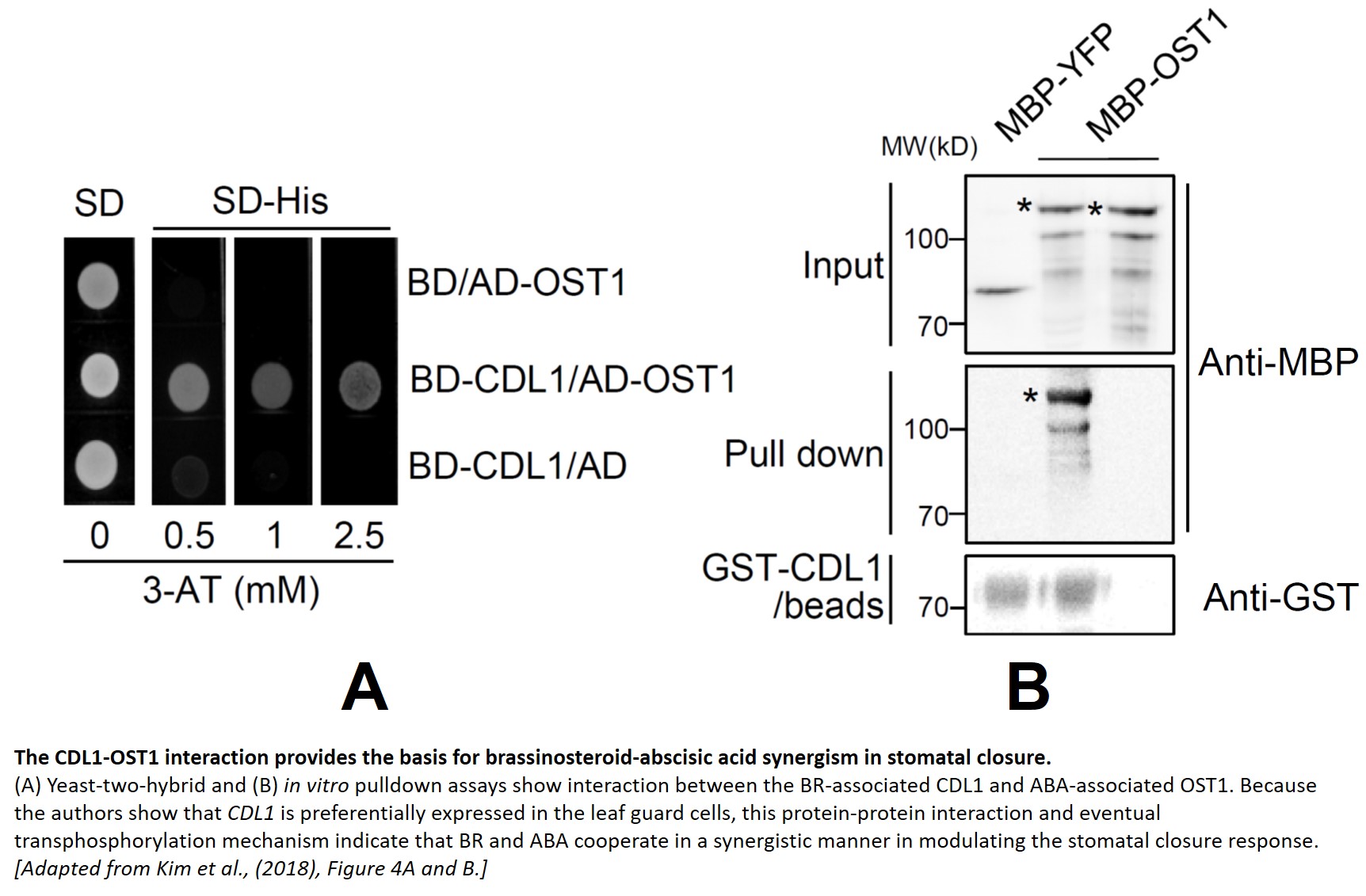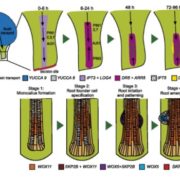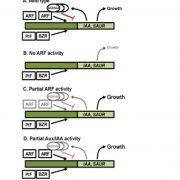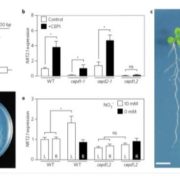CDL1-OST1 Interaction as a Focal Point of Brassinosteroid-Abscisic Acid Hormone Signaling Crosstalk
Plants integrate signals in the form of light, humidity, temperature, CO2 concentrations and daily circadian rhythms. In addition, plants encounter pathogens, pests, herbivores and other stressors. Physiological processes like responding to stimuli, plant growth and development are usually governed and coordinated by hormones. Because of the highly coordinated and complex nature of hormone signaling networks, different hormones cooperate in a synergistic matter or antagonize each other’s functions. For example, two hormones that are known to be antagonistic are brassinosteroids (BR) and abscisic acid (ABA) (Zhang et al., 2009).
Although their respective signal transduction pathways have been elucidated from hormone perception to transcriptional regulation, the nature of the BR-ABA interaction during the response to environmental stimuli (e.g. stomatal closure) remains unclear. In this study, Kim and colleagues (2018) demonstrate that, in contrast to their roles in growth and development, BR and ABA regulate stomatal closure in a synergistic fashion. This synergism is mediated through the newly discovered interaction between the BR-associated CDG1-LIKE 1 (CDL1) and ABA-associated OPEN STOMATA 1 (OST1) (see Figure).
An initial clue was found using a GUS reporter line, which exhibited high and preferential CDL1 expression in stomatal guard cells. Consequently, the authors hypothesized that CDL1 could play a role in stomatal responses. Because ABA is known to induce stomatal closure (Munemasa et al., 2015), they tested whether the cdl1 mutant is sensitive to ABA in this manner. Not only was this mutant ABA-insensitive in terms of its stomatal behavior, it also exhibited perturbed ABA-related responses, like reduced reactive oxygen species levels, higher water loss and decreased leaf temperature. Like ABA, the active form of BR called BL (brassinolide) also regulates stomatal closure (Ha et al., 2016). Similarly, the cdl1 mutant was insensitive to BL. Complementation of the cdl1 mutant with a wild-type allele of CDL1 recovered both ABA and BL sensitivity, indicating that CDL1 is involved in the stomatal response governed by these two hormones. Surprisingly, the function of CDL1 in stomatal closure is independent of BR biosynthesis and downstream signaling components.
ABA-induced stomatal closure depends on OST1 (Mustilli et al., 2002). What Kim et al. (2018) found is that the ost1 mutant is also insensitive to BR-mediated stomatal closure, phenocopying the cdl1 mutant. With these solid phenotypic characterizations on hand, they investigated a possible mechanism by which both CDL1 and OST1 mediate the stomatal response. Using yeast-two-hybrid, in vitro pulldown and co-immunoprecipitation approaches, they showed that CDL1 interacts with and phosphorylates OST1 (see Figure). This interaction is enhanced by BR and ABA treatments.
 Exploring further into how CDL1 phosphorylates OST1, possible serine (Ser) residues in OST1 were mutated. Based on previous structural studies of the protein, Ser166, Ser171 and Ser175 were mutated but these did not alter OST1 phosphorylation by CDL1. Instead, the Ser7 site of OST1 was determined to be the phosphorylation site of CDL1. The OST1 Ser7 mutant additionally had reduced phosphorylation and exhibited decreased ABA and BR sensitivity, reminiscent of the ost1 and cdl1 mutants. In vitro kinase assays demonstrated that OST1 and CDL1 phosphorylate each other, with ABA/BR treatments enhancing this transphosphorylation mechanism. Overall, the results of this study indicate that the synergistic action of ABA and BR in the guard cells is mediated by the interaction of CDL1 and OST1 – reflecting a new model of hormone crosstalk in stomatal movement. This further expands our understanding that hormone signaling is dynamically regulated in a spatio-temporal manner.
Exploring further into how CDL1 phosphorylates OST1, possible serine (Ser) residues in OST1 were mutated. Based on previous structural studies of the protein, Ser166, Ser171 and Ser175 were mutated but these did not alter OST1 phosphorylation by CDL1. Instead, the Ser7 site of OST1 was determined to be the phosphorylation site of CDL1. The OST1 Ser7 mutant additionally had reduced phosphorylation and exhibited decreased ABA and BR sensitivity, reminiscent of the ost1 and cdl1 mutants. In vitro kinase assays demonstrated that OST1 and CDL1 phosphorylate each other, with ABA/BR treatments enhancing this transphosphorylation mechanism. Overall, the results of this study indicate that the synergistic action of ABA and BR in the guard cells is mediated by the interaction of CDL1 and OST1 – reflecting a new model of hormone crosstalk in stomatal movement. This further expands our understanding that hormone signaling is dynamically regulated in a spatio-temporal manner.
REFERENCES
Ha Y, Shang Y, Nam KH (2016). Brassinosteroids modulate ABA-induced stomatal closure in Arabidopsis. J Exp Bot 67: 6297-6308.
Kim TW, Youn JH, Park TK, Kim EJ, Park CH, Wang ZY, Kim SK, Kim TW (2018). OST1 Activation by the Brassinosteroid-Regulated Kinase CDG1-Like 1 in Stomatal Closure. Plant Cell pii: tpc.00239.2018. DOI: 10.1105/tpc.18.00239.
Munemasa S, Hauser F, Park JY, Waadt R, Brandt B, Schroeder JI (2015) Mechanisms of abscisic acid-mediated control of stomatal aperture. Curr Opin Plant Biol 28: 154-162.
Mustilli AC, Merlot S, Vavasseur A, Fenzi F, Giraudat J (2002). Arabidopsis OST1 protein kinase mediates the regulation of stomatal aperture by abscisic acid and acts upstream of reactive oxygen species production. Plant Cell 14: 3089-3099.
Zhang S, Cai Z, Wang X (2009). The primary signaling outputs of brassinosteroids are regulated by abscisic acid signaling. Proc Natl Acad Sci USA 106: 4543-4548.









